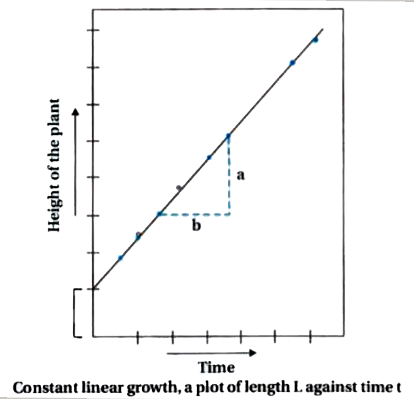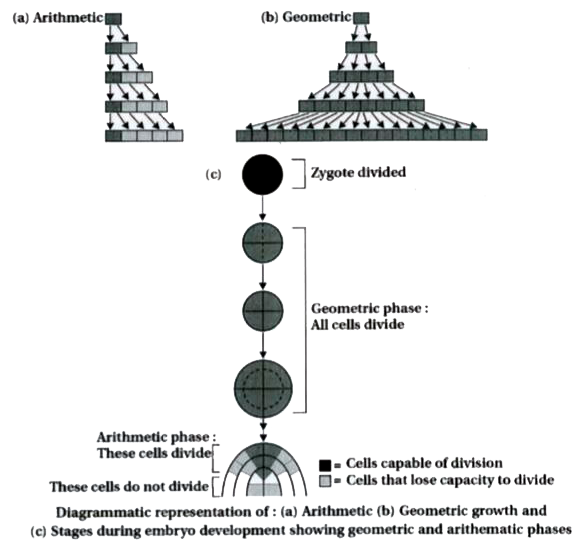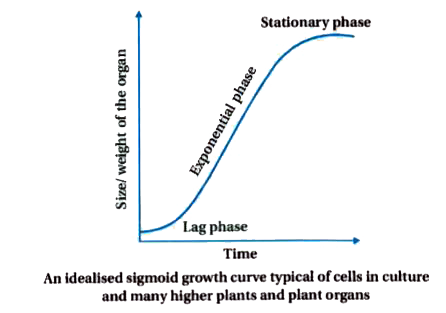Describe different types of growth rates.
Text Solution
The increased growth per unit time is termed as growth rate.
Thus, rate of growth can be expressed mathematically.
An organism or a part of the organism can produce more cells in a variety of ways.
Types : The growth rate shows an increase that may be arithmetic or geometrical.
Arithmetic growth : In arithmetic growth, following mitotic cell division, only one daughter cell continues to divide while the other differentiates and matures.
The simplest expression of arithmetic growth is exemplified by a root elongating at a constant rate.
Refer the above graph.
On plotting the length of the organ against time a linear curve is obtained.
Mathematically, it is expressed as.
Lt=Lo+rt
Lt=length at time t
Lo= length at time zero
r = growth rate/elongation per unit time.
Geometrical Growth : In living organisms during geometric type of growth rate pattern follows three important phases.
(a) Lag phase (Initial or the beginning phase) : It is mainly characterized by very slow growth.
(b) Log phase (exponential phase) : It is the middle phase of the system and is characterized by very fast and rapid growth of the plant body.
After initiation of growth, it increases rapidly at an exponential rate.
During this phase, both progeny cells undergoing mitotic cell division retain the ability to divide and continue dividing till the next phase appears till the time nutrient supply is appropriate.

Diagrammatic representation of: (a) Arithmetic (b) Geometric growth and (c) Stages during embryo development showing geometric and arithematic phases
Under favourable conditions the characteristic course of growth is observed. Thus, if we plot the parameter of growth rate against time the typical shaped, a sigmoid curve is seen.
It shows a characteristic feature of all living organism growing in a natural environment.
This curve is typeical for all cells, tissues and organs of a plant.

The exponential growth can be expressed as :
W=W0ert
Where W1= Final size (weight, height, number etc.)
W0= Initial size at the beginning of the period
t = Time of growth
e = Base of natural logarithms

r = Relative growth rate that measures the ability of the plant to produce new plant material, known as efficiency index.
The final size [W1] depends on the initial size [W0]
|
Topper's Solved these Questions
- PLANT GROWTH AND DEVELOPMENTBOOK - KUMAR PRAKASHANCHAPTER - PLANT GROWTH AND DEVELOPMENTEXERCISE - SECTION - B (DIFFERENCE/SCIENTIFIC REASONS)
16 Videos
- PLANT GROWTH AND DEVELOPMENTBOOK - KUMAR PRAKASHANCHAPTER - PLANT GROWTH AND DEVELOPMENTEXERCISE - SECTION - C (DEFINITION/EXPLANATION - TERMS/IMPORTANCE)
18 Videos
- PHOTOSYNTHESIS IN HIGHER PLANTSBOOK - KUMAR PRAKASHANCHAPTER - PHOTOSYNTHESIS IN HIGHER PLANTSEXERCISE - FILL IN BLANKS
10 Videos
- PLANT KINGDOMBOOK - KUMAR PRAKASHANCHAPTER - PLANT KINGDOMEXERCISE - OBJECTIVE SECTION (FILL IN THE BLANKS)
9 Videos
Similar Questions
Knowledge Check
Who described different types of personality based on glands?
AKretschmerBJungCCannonDSpranger
Describe different types of cross pollination in plants.
View SolutionDescribe different types of neurons on the basis of their functions.
View SolutionDescribe different types of pollination.
View SolutionExplain different types of growth models.
View SolutionDescribe different types of natural selection with the help of graphs.
View SolutionDescribe the different types of temperature scales commonly used.
View SolutionDescribe the different types of permanent tissues.
View Solution
